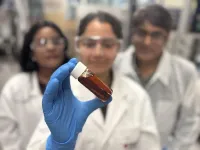(Press-News.org)
A study led by the Barcelona Institute for Global Health (ISGlobal), a centre supported by the "la Caixa" Foundation, has shown that Europe has adapted better to low temperatures than to high temperatures over the last two decades. The research, carried out in collaboration with the Barcelona Supercomputing Centre (BSC) and published in The Lancet Planetary Health, shows that there has been a significant decrease in cold-related mortality risk in recent years compared to the first decade of the 2000s. There has also been a reduction in the risk of heat-related deaths over this period, although to a lesser extent.
By analysing temperature and mortality records from over 800 regions in 35 European countries for the period 2003-2020, the researchers found that the relative risk of death in the lowest temperatures fell by 2% per year. On the other hand, the relative risk of death in the highest temperatures also decreased, but at a lower average rate of 1% per year.
New approach to account for regional differences
Traditionally, studies of this type have relied on fixed temperature thresholds to calculate risks, without taking into account that the vulnerability to identical temperatures is not the same in all parts of Europe. To overcome this limitation, the team developed a new concept: Extreme-Risk Temperature (ERT). By cross-referencing regional temperature and mortality data, this new approach made it possible to calculate the temperature at which the risk of death exceeds a certain threshold for each geographical area. The researchers also took into account variations in mortality to reflect adaptations to temperature over time.
Using this methodology, the team observed that in the period 2003-2020 Europe experienced 2,07 less dangerously cold days (cold-ERT days) each year. On the contrary, the dangerously hot days (heat-ERT days) increased by 0,28 days per year.
Interestingly, not all parts of Europe were affected the same way. For example, Southeastern European regions, despite its warmer conditions, had more dangerously heat and cold days that caused a higher risk of associated mortality.
“We have become better at coping with cold temperatures over time - a process known in science as 'adaptation'. For hot weather, people are also becoming resilient, though this improvement is less than the adaptation to cold”, says Zhao-Yue Chen, ISGlobal researcher and first author of the study.
"The vulnerability to extreme temperatures varies widely across different locations, with regions in Southern Europe being more sensitive to temperature changes than those in Northern Europe. This disparity is partially due to socioeconomic factors, including inadequate housing insulations, lower public health expenditure and limited access to social support or assistance for vulnerable populations", Zhao-Yue Chen adds.
"Our results show that, while Europe has done remarkable progress in adapting to cold, the strategies to cope with heat-related mortality have been less effective. A 2024 survey revealed that only 20 out of 38 European countries have implemented temperature surveillance systems, and 17 countries still do not have heat-health action plans (HHAPs). Our study highlights the need for more progress in current heat adaptation measures and heat-health action plans", says Joan Ballester Claramunt, ISGlobal researcher and senior author of the study. “At the same time the observed spatial disparities underscore the need for region-specific strategies to protect vulnerable populations”, he adds.
Combined effects of temperature and air pollution
The team also looked at how often Extreme-Risk Temperatures happened on days with pollution levels above the World Health Organization (WHO) recommended limits. The co-occurrence of these two events, known as 'compound days', happened on 60% of heat-ERT days and 65% of cold-ERT days. Over time, these combination days have been decreasing except for the combination of dangerously hot days and high levels of ozone (O3) pollution, which increased at a rate of 0.26 days per year.
Ozone is a secondary pollutant formed in the atmosphere as a result of the interaction between other gases and solar radiation. “As global warming intensifies, combined heat and ozone episodes are becoming an inevitable and pressing concern for Europe. We need to consider compound days and develop specific strategies to tackle secondary pollutants such as ozone, because the health impacts of extreme temperatures and air pollution are not completely independent. There is an interaction between them that can amplify adverse health effects," says Zhao-Yue Chen.
EARLY-ADAPT project
The study has been carried out in the context of the EARLY-ADAPT project (https://www.early-adapt.eu/), funded by the European Research Council, and aimed at studying how populations are adapting to the public health challenges triggered by climate change.
Reference
Zhao-Yue Chen, Hicham Achebak, Hervé Petetin, Raúl Fernando Méndez Turrubiates, Yuming Guo, Carlos Pérez García-Pando and Joan Ballester, Trends in Population Exposure to Compound Extreme-risk Temperature and Air Pollution across 35 European countries: a modeling study. The Lancet Planetary Health, 2025.
END
In a cave overlooking the ocean on the southern coast of South Africa, archaeologists discovered thousands of stone tools, created by ancient humans roughly 20,000 years ago. By examining tiny details in the chipped edges of the blades and stones, archaeologists are able to tell how the tools were made. In a new study published in the Journal of Paleolithic Archaeology, researchers analyzed these stone tools and discussed how the different techniques used to make them hint at the ways that prehistoric people traveled, interacted, and shared their craft.
“This is an important insight into how people who lived in this region ...
10 April 2025: The world’s first baby has been born following conception with a fully automated, digitally controlled intracytoplasmic sperm injection (ICSI) system. ICSI, developed and adopted into widespread use in the 1990s and now a routine method of assisted conception, achieves fertilisation by injecting a single sperm cell into the centre of a mature egg.
The details are reported today in the peer-review medical journal Reproductive Biomedicine Online.(1) The automated system was described and developed by a multidisciplinary team of specialists from Conceivable ...
Education projects supporting marginalised girls in lower-income countries are more likely to achieve lasting transformations when they mobilise young women and their communities as “agents of change”, a new report indicates.
The recommendation comes from the latest evaluation of the Girls’ Education Challenge: a UK Government-supported initiative which has funded projects reaching more than 1.6 million girls. The University of Cambridge-led study finds that these projects initiated “virtuous cycles” of change – particularly by rooting themselves in communities and empowering young women to lead the way.
In ...
New research suggests conservation efforts could more effectively identify and protect bird species at greatest risk from climate change by better understanding the range of specific conditions they need to thrive.
The study, led by the University of East Anglia (UEA), examined the relationship between the extent of the climatic conditions that species tolerate and in which populations can survive - known as climatic niche breadth - and their likelihood of declining in response to climate change.
For species inhabiting a similar area of geographic space, those able to tolerate ...
Astronomers have peered back in time to find what looks like a population of 'hidden' galaxies that could hold the key to unlocking some of the universe's secrets.
If their existence is confirmed it would "effectively break current models of galaxy numbers and evolution".
The possible galaxies may also provide the missing piece of the puzzle for the energy generation in the universe in infrared light.
That's because their combined light would be enough to top-up the energy budget of the universe to the maximum we observe, effectively ...
UNDER EMBARGO UNTIL 00:01 BST THURSDAY 10 APRIL / 19:01 ET WEDNESDAY 9 APRIL 2025
For the first time, a study led by University of Oxford researchers has ‘listened in’ to the fascinating courtship displays of Fiddler crabs using geophones. The findings, published today in the Journal of Experimental Biology, provide new insights into how the animals communicate effectively on the noisy seashore.
For male fiddler crabs, vibrational signals are a crucial part of their courtship routines – produced by drumming the ground using their oversized claw, ...
New research to be presented at this year’s European Congress on Obesity (ECO 2025, Malaga, Spain, 11-14 May) shows that patients using GLP-1 or combined GLP-1 / GIP receptor agonist therapy for weight loss experienced minimal lean muscle mass loss as they lost weight across 6 months of treatment. The study is by Dr Dinabel Peralta-Reich, Donald and Barbara Zucker School of Medicine at Hofstra/Northwell; Lenox Hill Hospital, Northwell Health, New York City, NY, USA, and Dr Alexandra Filingeri, New York Weight Wellness Medicine, New York City, NY, USA, and colleagues.
GLP-1 (glucagon-like peptide-1) receptor agonists, ...
Australian technology developed at RMIT University could enable more sustainable and cheaper production of bio-oils to replace petroleum-based products in electronic, construction and automotive applications.
The technology, known as PYROCOTM, uses high temperatures without oxygen to convert treated sewage (biosolids) into a carbon-rich product called biochar, which can act as a catalyst to produce phenol-rich bio-oil.
PYROCOTM has been developed by RMIT in collaboration with South East Water, Intelligent Water Networks and other water authorities over several years and is now being applied to several exciting circular economy applications.
The RMIT team's latest research in collaboration ...
An international team of researchers led by Professor Huaijun Zhou from the UC Davis Department of Animal Science has created the first-ever detailed map of how genes are regulated in chickens — a breakthrough that could help scientists breed birds that are more resistant to diseases like avian influenza.
The study, published April 8 in Nature Genetics, brings together a massive amount of genetic and epigenetic data of more than 100 chicken breeds from around the world. The team, which ...
What: In a massive scientific effort funded by the National Institutes of Health (NIH), hundreds of researchers have helped to map the connections between hundreds of thousands of neurons in the mouse brain and then overlayed their firing patterns in response to visual stimuli. This breakthrough is a critical piece of foundational science to build toward understanding how our brains process visual information to reconstruct the images we see every day.
Information processing in the human brain occurs ...







